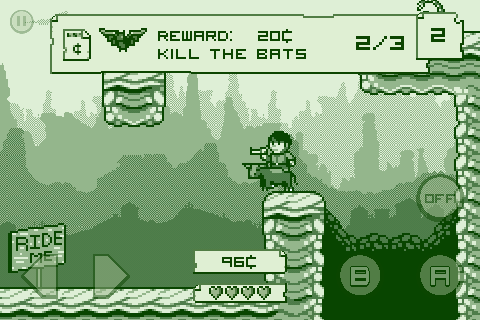"TVs are the Future for Mobile Games" Claims 2-bit Cowboy Dev Cascadia Games

Update: The game is now on sale. Grab it here.
Original Story: iOS gamers are in for a treat this Thursday May 8, when 2-bit Cowboy rides into town. It’s good. Really good.
I’ve had the pleasure of playing it for the last few days, and I can happily say to anyone who has fears of 2D platforming on a touchscreen, fear not. The controls are spot on, freeing you up to explore the large levels with confidence, not frustration. You’ll be swimming, horse and bull-riding, mine-carting and, of course, six-gun shooting - all without the pressure of annoying timers or tiny bite-size levels that plague so many iOS platformers.
Developer Cascadia Games has packed a lot into 2-bit Cowboy, but then left it up to the player to decide how deeply they want to explore the environments. There are plenty of hidden coins to be found and reward posters that provide you with missions to complete. Complete these tasks, reap the bounty and buy hats. So many glorious hats. Oh, and masks, facial customisations, belts and even the choice between playing as a cowboy or cowgirl.
We reached out and spoke to Chris Jorgensen - owner of Cascadia Games - to find out more about the inspirations behind 2-bit Cowboy. We end up venturing off into some pretty interesting territory, discussing MFi controllers and iOS gaming on flatscreen TVs.
2-bit Cowboy wears its Game Boy inspirations proudly on its sleeve, and retro-styled graphics are a popular fixture on the App Store. What are your thoughts on why the visual styles of the platforms of yesteryear seem to resonate so well on iOS?
Demographics, primarily. There are a lot of iOS users that are in their 30s, give or take a few years. We all grew up on Nintendo, Sega, and MS-DOS games. Retro-style games tap into the nostalgia for our childhoods.
To a lesser extent, I think “simple” games work well on mobile devices. Game sessions are shorter so the gameplay can’t be too deep or have too steep of a learning curve. That fits nicely with “retro” game genres from the 80s and early 90s, which tended to be simple or ports of arcade games that had similar requirements. The pixel graphics almost are a subconscious trigger for players, setting up expectations that the gameplay will fall into one classic genre or another.
In my brief time with your game so far, the controls are really nice and precise, allowing for some tight platforming, shooting and dodging of enemy’s bullets. Did you try different control schemes before arriving at the final one? On your site you mention a strong League of Evil influence, do you mean in the way of the controls?
I didn’t go into it with any other intent than to make a very precise, on-screen gamepad. I don’t find swipe controls or auto-movement particularly compelling for platformers. My focus from the beginning was to make a great gamepad.
There are really two tiers that you have to take care of when implementing platformer controls. The first is just making the gamepad responsive and fit the screen well. The second is creating rules for the player movement that feel empowering and intuitive.
Specifically from League of Evil, I borrowed the in-air jump and the wall sliding. The in-air jump can either be used as a double-jump to gain access to higher areas or be used as a little bit of insurance; say you fall and miss a platform, then you can recover with a quick in-air jump. That goes a long way toward easing frustration that might come with the lack of physical buttons. The wall scaling is nice because it affords the player the ability to climb anywhere there’s a wall and also how slowly the player moves down into danger.
I’ll find I often get excited by an iOS platformer’s screenshots only to find bite-sized levels or the pressure of timers to complete levels. With 2-bit Cowboy I’m enjoying the freedom to explore that the game allows, and you’ve coined the term “Westernvania” to describe the game. Do you feel there’s a lack of these more exploratory 2D platformers on iOS? If so why do you think this might be?
I share that frustration. I think there’s an assumption that platformers need to be mobile-compatible - that is, gamers are only playing them as distractions (while waiting in line for movie tickets or for a table at a restaurant) rather than sitting down with time dedicated to playing games. Exploration isn’t possible in 30 seconds, so every game ends up with short A-to-B levels with a handful of obstacles. At the same time, there’s so much pressure to provide the biggest bang for a buck, that game developers would rather say their game has 50 levels than 10, even though those 50 levels may be incredibly shallow. I think those factors are why we see so few exploratory platformers.
I can’t take credit for the term “Westernvania.” Josh of Crescent Moon Games actually coined it when we chatted about the game early in its development. (He forgot that he invented it, incidentally.) With that said, I had it in my head early to do something in between a casual League of Evil and a simplified Metroidvania. The result was big levels to optionally explore. If you get tired of a level, it’s pretty easy to move onto the next one. The challenge is left in finding reward posters and claiming the reward once you’ve completed its task. My hope is that players feel rewarded for exploring because of that.
On your blog there is a detailed review you’ve done of Logitech’s PowerShell controller for iOS, in which you outline many of the device’s shortcomings. How do you think the overall MFi controller scene is going as it doesn’t seem to have taken off yet since the program’s release last year? Any thoughts as to why?
I don’t think the gamepads are offering much new. If you’re a gamer, you’re probably skilled at playing games with touch-screen controls at this point. If you’re not a gamer, you’re likely not into the kind of games that play better with physical controls. That leaves a pretty small niche of potential players that will find mobile games suddenly far better by buying an MFi controller.
A big issue is that all games, as of right now, still need to support 100% phone-based controls (screen, tilt, etc). There are certain games like Halo, for example, that play great with a gamepad but require triggers, buttons, dual sticks, etc. It’s a huge challenge to introduce that depth of control without a gamepad. Another example is arcade fighters like Street Fighter. There’s no practical way to put six buttons and an arcade stick on-screen. Touch gestures are too slow for the genre. As a developer you’re stuck with being forced to create a simplified version of the game or compromising on controllability.
The best thing Apple could do to boost MFi controller games is to create a special section of the App Store for gamepad-only games. That would make the developer’s job easier and pave the way for more of a console experience from a mobile device.
My own feelings are that MFi controllers would best be marketed towards gaming on the larger flat screens of TVs. This could be done via devices such as your very own GameDock, or a potential Apple mini console in some form. What sort of market do you think there is for gaming that falls between the bigger consoles (Xbox, PlayStation) and mobile gaming?
Agreed that TVs are the future for mobile games. I believe ultimately mobile devices will overtake dedicated consoles, much like consoles overtook arcade cabinets. The big limiter right now is a lack of low-latency wireless video transmitted from the phone to the TV. Once that is available, however, why would one even bother with a big box wired up to a TV? Now I can go into any room with a screen and see my movies and games immediately, using my phone. I can imagine a technology like iBeacon being used such that I wouldn’t even need to touch my phone for it to connect to my TV and start transmitting.
Micro-consoles I think are just a transition technology. I’m not convinced a $99 Apple TV or Fire TV, when paired with a $49 controller, is suddenly going to overtake buying a $199 Xbox 360. For the former, there is a majority of users who have the device for something other than games, whereas folks buy the latter primarily for games. Developers I doubt will flock to that small of a niche. I’d love to see one of those devices take off. But I’m not convinced that one will.
What are your thoughts on iOS being able to compete in that market?
In my opinion, iOS is the best mobile operating system by far. If anyone can make a seamless small-to-big screen experience, it’s Apple. Like I said, if they can get AirPlay’s latency low enough, then mobile devices have a chance to become the home gaming system.
We’ll review 2-bit Cowboy in full for the next episode of Grab It, but for now you can check out the brand new hot off the shelf trailer just released today. Also Cascadia’s Cavorite series is available at the links below.
References:
- Cavorite
- Cavorite: Power pf the Gem
- Cavorite: Princess of the Moon
Have you collected every episode of Grab It?
- Episode 1 - With The Making of République
- Episode 2 - With The Making of Oceanhorn
- Episode 3 - With The Making of Monument Valley
- Episode 4 - With The Making of Last Inua
Writer:
Garry Balogh


